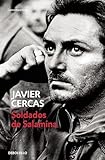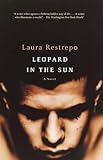When I was a child growing up in Guatemala during the Civil War, my mom took me to play at my friend’s house late one night. She told me not to ask any questions. “Just play,” she said. While our mothers sat downstairs talking in hushed voices, my friend took me into his closet to tell me quietly that armed men had surrounded their car earlier that day, threatening kidnapping or worse if they did not pay. We sat in the dark closet, crying, shooting our toy guns at nothing and everything, afraid and angry. My friend’s family fled the country. Some time later, men dressed in army fatigues kidnapped a cousin in our family for ransom. They returned him without physical harm, but not without emotional damage—his wife passed away not long after and our cousin hired security personnel. You could never be sure whether these were military, paramilitary, guerrilla, or mercenary cells targeting families.
I had yet to read an account that could begin to touch on the looming presence of dread families suffered when political violence invaded private life in Latin America in the late 20th century until I picked up Ingrid Rojas Contreras’s novel Fruit of the Drunken Tree. She weaves a tender-yet-gritty tapestry of the Santiagos, a family who lives in Bogotá, Colombia, during Pablo Escobar’s narco-terrorist reign. While most works about Escobar perpetuate the drug lord’s myth by attempting to understand the man, Fruit of the Drunken Tree unpacks the collateral damage the origins of this very myth inflicted on families and provides an understanding of their personal loss. The shortlist of works inspired by Escobar’s life out today—ESPN’s The Two Escobars and Netflix’s Narcos, the films Blow and American Made, and memoirs from former associates and family members—are mostly from men and about men, guns, and cocaine. But Rojas Contreras exposes another reality, one of strong women and girls who survive the Escobar years.
Born in Bogotá, Rojas Contreras holds an MFA from Columbia College Chicago, and Fruit of the Drunken Tree is her debut. A family story at heart, Fruit is told from the dual perspective of 7-year-old Chula Santiago and their young and impoverished maid, Petrona. The novel opens with Chula contemplating a photograph depicting Petrona, her son, and her husband. Readers learn it’s sent in secret from Colombia, as the Santiagos now live in California as refugees. Chula misses her friend and tries to remember how they ended up in a foreign country, separated from their family. What follows is a retelling that begins with this whisper of a memory and ends with a guttural yelp of personal loss that refuses to be silenced.
Chula and Petrona’s accounts give readers a look into how an unassuming middle-class family could become embroiled in political violence extreme enough to fracture social classes. While Petrona lives in the invasiones—shack communities along the outskirts of Bogotá—Chula’s mother has made it out of this poverty years earlier and marries well. This sets up Chula’s connection to and fascination with Petrona.
If women stand front and center in Fruit, men remain in the periphery, though ever powerful. Chula and her sister grow up in a “kingdom of women, with Mamá at the head, perpetually trying to find a fourth like us, or a fourth like her.” The fourth becomes Petrona. Her joining the family creates a female nucleus, the father working for an American oil company and often gone on business. Though men remain at a distance in the novel, they retain their influence over women and country: Most conversations Chula and the family have with their father are on the phone, as the girls eagerly await his return. Mamá decorates her room with posters of presidential hopeful Luis Carlos Galán, lauding him as the savior of Colombia. Escobar dances on the tongues of news anchors and on the typewriters of journalists. Even Petrona’s boyfriend who joins the encapotados—gangs loosely affiliated to Escobar associates and paramilitary cells—walks in and out of shadows at night both in the invasiones and when in Bogotá. Men seem unreachable, mythological, yet always desired. Men also orchestrate violence, unpredictable and bloody, from a distance. So it is this “kingdom of women” that must rise above, in spite of men, in order to survive.
What grounds Fruit is how it destroys these myths the closer we get to the violence. As Chula goes from obsessing over the gory images she sees on TV to hearing of gory images near her home to suffering through gory images themselves, both reader and character find the gory reality of violence kills and hurts. After watching a news clip about a recent car-bomb explosion near their neighborhood, Chula never rids herself of the image of a girl’s dismembered leg with a “blackened red shoe and a smoky white sock.” She recognizes the street and makes a connection, violence no longer a figment of her imagination. In response, she and her sister decide to prepare backpacks in case of a bombing. They play with their Barbie collection, tearing off their limbs for storylines. Petrona, who rarely speaks more than a sentence, joins this play and connects with Chula through the re-enacted violence (not long before, her little brother Ramón had been shot dead at a park near her home in the invasiones).
But it’s not until violence reaches her home that it becomes real to Chula. Until then, she participates in myth-making, even after she, her sister, and her mother witness Galán’s assassination at a political rally. She enjoys the attention she receives when she retells escalating versions of her experience: “The news didn’t say this—but Pablo Escobar was there, in flesh and blood. I saw his face lit up by the fire of his own machine gun.” There’s something alluring in adding to Escobar’s myth. When a car bomb explodes outside their home one morning, however, and glass rains down on her from the shattered bedroom window as she sleeps, Chula begins to understand how much she doesn’t understand.
 Rojas Contreras shines most when she uses Chula’s naïve child perspective, emulating Colombia’s own conflicting obsession over and disgust with Escobar. The images Chula sees on television, in person, and then experiences conflate into a strange amalgamation of reality and myth. As readers, our hearts break as we witness her come of age and as the Santiagos suffer through an onslaught of violence that comes after the car bomb.
Rojas Contreras shines most when she uses Chula’s naïve child perspective, emulating Colombia’s own conflicting obsession over and disgust with Escobar. The images Chula sees on television, in person, and then experiences conflate into a strange amalgamation of reality and myth. As readers, our hearts break as we witness her come of age and as the Santiagos suffer through an onslaught of violence that comes after the car bomb.
 Even when Rojas Contreras explores religious myths, a topic often untouched yet of great importance in Latin American culture, she places the reader at a discrete aesthetic distance through Chula’s eyes. In one scene, Chula watches from a church pew as Petrona takes her First Communion and listens to the priest: “the Father opened his arms and asked for all the kids to be possessed by spirits: some nice, like the Spirit of Wisdom and Intelligence, but some dubious, like the Spirit of Holy Fear.” The reader experiences life with Chula at a discrete aesthetic distance, as characters commune within religious and socio-political myths.
Even when Rojas Contreras explores religious myths, a topic often untouched yet of great importance in Latin American culture, she places the reader at a discrete aesthetic distance through Chula’s eyes. In one scene, Chula watches from a church pew as Petrona takes her First Communion and listens to the priest: “the Father opened his arms and asked for all the kids to be possessed by spirits: some nice, like the Spirit of Wisdom and Intelligence, but some dubious, like the Spirit of Holy Fear.” The reader experiences life with Chula at a discrete aesthetic distance, as characters commune within religious and socio-political myths.

 Through Chula and Petrona, Rojas Contreras delivers a story told with honesty and empathy for her characters. As such, Fruit reads like a third novel, not a debut—confident in its delivery, earnest in its subject matter. It also bolsters a female, Latin American voice that must be heard loud and clear.
Through Chula and Petrona, Rojas Contreras delivers a story told with honesty and empathy for her characters. As such, Fruit reads like a third novel, not a debut—confident in its delivery, earnest in its subject matter. It also bolsters a female, Latin American voice that must be heard loud and clear.
 Rojas Contreras joins an emerging set of Colombian writers whose work reaches across geographic borders and looks back on the late 20th century with a critical eye. Similar to the Spanish “postmemory” movement that rummaged through the effects of the Spanish Civil War on families—helmed by Javier Cercas’s Soldados de Salamina and Dulce Chacón’s La voz dormida, among others—Rojas Contreras, Juan Gabriel Vásquez (El ruido de las cosas al caer), and Laura Restrepo (El leopardo al sol) rummage through their own memories of narco-terrorism and its effect on Colombian families.
Rojas Contreras joins an emerging set of Colombian writers whose work reaches across geographic borders and looks back on the late 20th century with a critical eye. Similar to the Spanish “postmemory” movement that rummaged through the effects of the Spanish Civil War on families—helmed by Javier Cercas’s Soldados de Salamina and Dulce Chacón’s La voz dormida, among others—Rojas Contreras, Juan Gabriel Vásquez (El ruido de las cosas al caer), and Laura Restrepo (El leopardo al sol) rummage through their own memories of narco-terrorism and its effect on Colombian families.
 It’s difficult to speak of Colombian literature without mentioning Gabriel García Márquez’s magical realism, or women writers in general without the likes of Chilean-born Isabel Allende and later Cuban-born Cristina García in Dreaming in Cuban. These authors write about myth to explore family and politics, and they pay special attention to the role of mothers and women in society. But it’s worth returning to Julia Álvarez’s experimental novel How the García Girls Lost their Accent, which retells how a family flees from Trujillo’s dictatorship in the Dominican Republic to the States, in order to arrive at Fruit and grasp how Latin American and LatinX people have developed beyond magical realism and explaining myth. Rojas Contreras carries the torch forward by deconstructing the myths that have tethered the cultural fabric of Latin America through an investigative realism.
It’s difficult to speak of Colombian literature without mentioning Gabriel García Márquez’s magical realism, or women writers in general without the likes of Chilean-born Isabel Allende and later Cuban-born Cristina García in Dreaming in Cuban. These authors write about myth to explore family and politics, and they pay special attention to the role of mothers and women in society. But it’s worth returning to Julia Álvarez’s experimental novel How the García Girls Lost their Accent, which retells how a family flees from Trujillo’s dictatorship in the Dominican Republic to the States, in order to arrive at Fruit and grasp how Latin American and LatinX people have developed beyond magical realism and explaining myth. Rojas Contreras carries the torch forward by deconstructing the myths that have tethered the cultural fabric of Latin America through an investigative realism.
The post Deconstructing Myths and Male Influence in ‘Fruit of the Drunken Tree’ appeared first on The Millions.
from The Millions https://ift.tt/2LSa2TR
Comments
Post a Comment